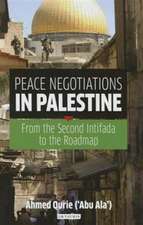Neighbourhood Perceptions of the Ukraine Crisis: From the Soviet Union into Eurasia?: Post-Soviet Politics
Editat de Gerhard Besier, Katarzyna Stoklosaen Limba Engleză Paperback – 14 aug 2018
| Toate formatele și edițiile | Preț | Express |
|---|---|---|
| Paperback (1) | 242.71 lei 6-8 săpt. | |
| Taylor & Francis – 14 aug 2018 | 242.71 lei 6-8 săpt. | |
| Hardback (1) | 821.14 lei 6-8 săpt. | |
| Taylor & Francis – 17 noi 2016 | 821.14 lei 6-8 săpt. |
Din seria Post-Soviet Politics
-
 Preț: 355.98 lei
Preț: 355.98 lei - 25%
 Preț: 324.16 lei
Preț: 324.16 lei - 28%
 Preț: 739.39 lei
Preț: 739.39 lei -
 Preț: 465.91 lei
Preț: 465.91 lei - 18%
 Preț: 1005.46 lei
Preț: 1005.46 lei - 15%
 Preț: 669.94 lei
Preț: 669.94 lei -
 Preț: 376.37 lei
Preț: 376.37 lei -
 Preț: 489.26 lei
Preț: 489.26 lei - 18%
 Preț: 1114.70 lei
Preț: 1114.70 lei - 19%
 Preț: 247.40 lei
Preț: 247.40 lei - 15%
 Preț: 705.53 lei
Preț: 705.53 lei - 19%
 Preț: 259.07 lei
Preț: 259.07 lei - 30%
 Preț: 769.00 lei
Preț: 769.00 lei - 31%
 Preț: 766.57 lei
Preț: 766.57 lei - 18%
 Preț: 1002.63 lei
Preț: 1002.63 lei - 15%
 Preț: 259.51 lei
Preț: 259.51 lei -
 Preț: 382.75 lei
Preț: 382.75 lei -
 Preț: 381.81 lei
Preț: 381.81 lei -
 Preț: 386.39 lei
Preț: 386.39 lei -
 Preț: 319.91 lei
Preț: 319.91 lei -
 Preț: 385.62 lei
Preț: 385.62 lei -
 Preț: 387.91 lei
Preț: 387.91 lei -
 Preț: 388.26 lei
Preț: 388.26 lei -
 Preț: 385.71 lei
Preț: 385.71 lei -
 Preț: 396.29 lei
Preț: 396.29 lei - 18%
 Preț: 1005.17 lei
Preț: 1005.17 lei - 18%
 Preț: 1007.48 lei
Preț: 1007.48 lei - 18%
 Preț: 1053.33 lei
Preț: 1053.33 lei - 28%
 Preț: 496.94 lei
Preț: 496.94 lei
Preț: 242.71 lei
Preț vechi: 289.62 lei
-16% Nou
Puncte Express: 364
Preț estimativ în valută:
46.45€ • 50.44$ • 39.02£
46.45€ • 50.44$ • 39.02£
Carte tipărită la comandă
Livrare economică 22 aprilie-06 mai
Preluare comenzi: 021 569.72.76
Specificații
ISBN-13: 9781138361300
ISBN-10: 1138361305
Pagini: 282
Ilustrații: 8
Dimensiuni: 156 x 234 x 27 mm
Greutate: 0.53 kg
Ediția:1
Editura: Taylor & Francis
Colecția Routledge
Seria Post-Soviet Politics
Locul publicării:Oxford, United Kingdom
ISBN-10: 1138361305
Pagini: 282
Ilustrații: 8
Dimensiuni: 156 x 234 x 27 mm
Greutate: 0.53 kg
Ediția:1
Editura: Taylor & Francis
Colecția Routledge
Seria Post-Soviet Politics
Locul publicării:Oxford, United Kingdom
Cuprins
Contents
List of illustrations
Notes on contributors
List of abbreviations
1 Introduction
Gerhard Besier and Katarzyna Stokłosa
2 European Union conflict transformation as cross-border co-operation: potential and limits
Cathal McCall
3 Reconceptualizing European neighbourhood beyond geopolitics: observations on eastern partnership
James Wesley Scott
Part I Russia and Ukraine: an ambivalent neighbourhood
4 Russian perceptions of the Ukrainian crisis: from confrontation to damage limitation?
Alexander Sergunin
5 A squeezed country: Ukraine between Europe and Eurasia
Mikhail A. Molchanov
Part II Russian borders in the light of the crisis
6 Shifting borders: unpredictability and strategic distrust at the Finnish–Russian border
Jussi Laine
7 Russia–EU borderlands after the Ukraine crisis: the case of Narva
Andrey Makarychev And Alexandra Yatsyk
8 Invested in Ukraine: the struggle of Lithuania against Russia over the future of Europe
Dovilė Jakniūnaitė
9 Fearing the worst: a Latvian view on Russia and the conflict in Ukraine
Ilvija BruĢe and Kārlis Bukovskis
10 T he return of geopolitics: Georgia in the shadow of Russian–Ukrainian conflict
Kornely Kakachia
11 Having deja vu: the perception of the Ukrainian crisis in the Republic of Moldova
Corneliu Pintilescu and Onoriu Colăcel
12 Ukraine and Russia in crisis: a Polish view
Katarzyna Stokłosa
13 T he Caspian States’ perception of the conflict between Ukraine and Russia
Justyna Misiągiewicz
Part III Ukrainian–Russian conflict: world views, belief systems and ideologies as sources and instruments
14 Sources of popular support and opposition to the Putin regime
Cameron Ross
15 Expanding religious borders? The new influence of some old state churches: the Russian Orthodoxy
Gerhard Besier
16 Ukraine: historical notes on reunification of the Russian lands
Jukka Korpela
Index of persons
Index of places
List of illustrations
Notes on contributors
List of abbreviations
1 Introduction
Gerhard Besier and Katarzyna Stokłosa
2 European Union conflict transformation as cross-border co-operation: potential and limits
Cathal McCall
3 Reconceptualizing European neighbourhood beyond geopolitics: observations on eastern partnership
James Wesley Scott
Part I Russia and Ukraine: an ambivalent neighbourhood
4 Russian perceptions of the Ukrainian crisis: from confrontation to damage limitation?
Alexander Sergunin
5 A squeezed country: Ukraine between Europe and Eurasia
Mikhail A. Molchanov
Part II Russian borders in the light of the crisis
6 Shifting borders: unpredictability and strategic distrust at the Finnish–Russian border
Jussi Laine
7 Russia–EU borderlands after the Ukraine crisis: the case of Narva
Andrey Makarychev And Alexandra Yatsyk
8 Invested in Ukraine: the struggle of Lithuania against Russia over the future of Europe
Dovilė Jakniūnaitė
9 Fearing the worst: a Latvian view on Russia and the conflict in Ukraine
Ilvija BruĢe and Kārlis Bukovskis
10 T he return of geopolitics: Georgia in the shadow of Russian–Ukrainian conflict
Kornely Kakachia
11 Having deja vu: the perception of the Ukrainian crisis in the Republic of Moldova
Corneliu Pintilescu and Onoriu Colăcel
12 Ukraine and Russia in crisis: a Polish view
Katarzyna Stokłosa
13 T he Caspian States’ perception of the conflict between Ukraine and Russia
Justyna Misiągiewicz
Part III Ukrainian–Russian conflict: world views, belief systems and ideologies as sources and instruments
14 Sources of popular support and opposition to the Putin regime
Cameron Ross
15 Expanding religious borders? The new influence of some old state churches: the Russian Orthodoxy
Gerhard Besier
16 Ukraine: historical notes on reunification of the Russian lands
Jukka Korpela
Index of persons
Index of places
Notă biografică
Gerhard Besier is currently Director of the Sigmund Neumann Institute (Berlin, Dresden, Flensburg) and teaches at Stanford University, USA.
Katarzyna Stokłosa is Associate Professor in the Department of Political Science and Public Management, Centre for Border Region Studies at the University of Southern Denmark, Denmark.
Katarzyna Stokłosa is Associate Professor in the Department of Political Science and Public Management, Centre for Border Region Studies at the University of Southern Denmark, Denmark.
Descriere
Discussing different perceptions of the Ukrainian-Russian war in neighbouring countries, this book offers an analysis of the conflicts and issues connected with the shifting of the border regions of Russia and Ukraine to show how ’material’ and ’psychological’ borders are never completely stable ideas.















